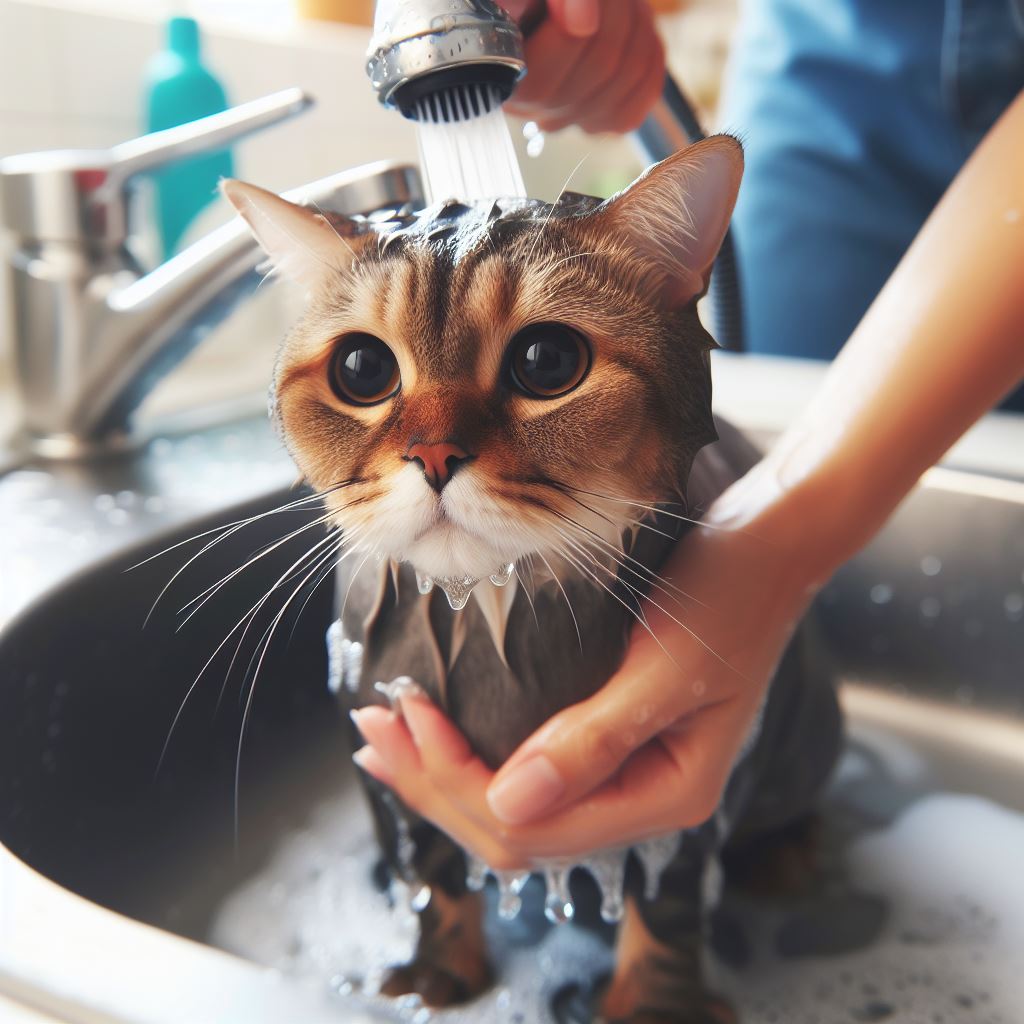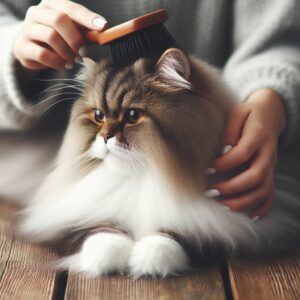Mastering the Art of Cat Bathing:
Expert Tips and Techniques
How To Bathe a Cat Without Stress
Here’s a little secret: cats occasionally require help keeping themselves clean. Despite their reputation for self-grooming, there are occasions when they might benefit from human assistance to maintain their immaculate appearance. Beyond being beautiful, this is essential to their general health and well-being.
You may be aware of the misconception that cats never need a bath and are self-sufficient in hygiene. Even if they take plenty of time to groom themselves, occasional baths are still necessary. Situations like clinging materials, offensive smells, or coping with skin ailments go beyond their grooming skills. This is where your help is beneficial.
Are you unsure of the right time to use the shampoo? Watch out for telltale symptoms like dandruff, a greasy or lifeless coat, or strange smells. Furthermore, watch for any skin issues requiring a bath, such as fleas or allergies. Prepping the tub may become more regular if you are the proud owner of one of the few breeds with noticeably thick or long fur, like Persians or Maine Coons.
The key to a successful cat bath is being well-prepared and completely grasping your cat’s needs. Prepared and wise, you can move seamlessly into bath time setup—a subject we’ll cover in a moment.
Preparing for a Feline Bath Time
Together, we can ensure that taking a bath will not cause any worry for you or your pet. The key to a flawless cat bathing experience is preparation, which starts long before water is used.
- Let’s start by discussing choosing the ideal shampoo. Gentleness is just as vital as cleanliness for your cat’s sensitive skin. Select a cat-specific shampoo, preferably one your cat’s doctor recommends. Human shampoos can deplete your cat’s coat of essential oils, which could irritate it.
- Before you begin, gather a few necessities. Grab a couple of towels, a spray nozzle or a pitcher, and a non-slip mat to place in the sink or bathtub. These are essential for controlling the water flow and relieving your cat’s anxiety while bathing them. Remember that staying composed and taking your time are necessary for success.
- Creating a peaceful environment can avoid a frenzy of claws and teeth. This implies that you might use a pheromone diffuser or play relaxing music while the cat is in the bathtub or the sink. Anything that soothes and comforts your cat will be your ally.
 Also, remember to clip your cat’s claws. This is an important step for your pet’s comfort and your own safety. By keeping your cats claws clipped, you can lessen the chance of scratches and your cat’s tendency to grab on to objects when it’s uncomfortable.
Also, remember to clip your cat’s claws. This is an important step for your pet’s comfort and your own safety. By keeping your cats claws clipped, you can lessen the chance of scratches and your cat’s tendency to grab on to objects when it’s uncomfortable.
Now that you’re all set, let’s get started on giving your cat a bath without making it messy or violent.
The Step-by-Step Guide to Bathing Your Cat
It’s time to tackle the primary task: giving your feline companion a bath. You’ve gathered all your supplies and set up your allocated bathing space. Though at first this might seem overwhelming, do not worry! I’ll walk you through every step of the procedure to ensure it’s easy and comfortable for you and your cat. If you have a little patience and attention to detail, you can confidently take on this work. Now, let’s get going!
- Getting your cat used to the water gradually is essential for a positive bathing experience. Let them first get acquainted with the sounds of flowing water and the feel of a wet cloth. Gradually raise their exposure to these substances while carefully monitoring their responses and letting them adjust at their own speed. They’ll get more at ease with taking baths in general as they get used to the concept of getting wet. This methodical technique reduces stress for your kitty friend and fosters trust.
- Moving on to the cleaning procedure, use a light hand and talk in a calming voice to keep your cat calm. Use caution when using the cat-safe shampoo, being sure to avoid sensitive regions like the face, ears, and especially the eyes. Just give these sensitive areas a gentle wipe-down with a damp cloth. Your cherished feline friend will have a peaceful and cozy bathing experience if you proceed with care and attention.
- Rinsing is as equally important as is the first soapy wash. It is imperative to fully remove the shampoo in order to avoid any possible skin irritation. Using a handheld spray nozzle can make this process simpler, but if one is not available, gently pouring water from a pitcher will still produce the same results. Make sure to cover everything thoroughly, and make sure to rinse your cat’s fur until the water runs clear. This thorough rinse procedure ensures a hygienic and cozy experience while supporting your cat’s general health and preserving the health of their skin.
 After giving your cat a bath, wrap them up in a warm towel right away. This is a very important step since cats can get quite cold very quickly. Besides being a reassuring gesture, the warm embrace of the towel helps ease the cats’ post-bath anxiety. Make sure your cat is cozy and dry by gently massaging away any extra water. You can speed up the drying process by using a hairdryer set on a low, warm setting if your cat isn’t too bothered by the noise. But always put your cat’s comfort and well-being first and modify your methods as necessary to make sure they have a good experience.
After giving your cat a bath, wrap them up in a warm towel right away. This is a very important step since cats can get quite cold very quickly. Besides being a reassuring gesture, the warm embrace of the towel helps ease the cats’ post-bath anxiety. Make sure your cat is cozy and dry by gently massaging away any extra water. You can speed up the drying process by using a hairdryer set on a low, warm setting if your cat isn’t too bothered by the noise. But always put your cat’s comfort and well-being first and modify your methods as necessary to make sure they have a good experience.
In the next section, I will discuss what to do after your cat is clean and dry. It’s not only about finishing the bath; it’s also about protecting your cat’s skin and coat and creating a nice experience. By following the proper post-bath care regimen, you can protect your cat’s health and help them feel more at ease during bath times in the future.
Post-Bath Tips and Cat Grooming Maintenance
After you’ve successfully navigated the splish splash of bath time, it’s critical to focus on what comes next. Making sure your cat dries completely is as important as giving them a bath. The risk of skin issues from a damp coat emphasizes the significance of using the right drying methods. Use a towel or a warm, low-temperature blow dryer to completely dry your cat to ensure their comfort and general health after bathing.
 Regular brushing is essential to maintaining the gorgeous coat of your cat. Regular brushing is an essential habit for any pet, regardless of whether it is a long-haired Persian or a short-haired tabby. It reduces shedding, but it also keeps uncomfortable matting at bay and makes it easier for their skin to absorb natural oils evenly. You can improve your cat’s coat health and beauty, as well as the relationship between you and your cherished companion, by grooming them on a regular basis.
Regular brushing is essential to maintaining the gorgeous coat of your cat. Regular brushing is an essential habit for any pet, regardless of whether it is a long-haired Persian or a short-haired tabby. It reduces shedding, but it also keeps uncomfortable matting at bay and makes it easier for their skin to absorb natural oils evenly. You can improve your cat’s coat health and beauty, as well as the relationship between you and your cherished companion, by grooming them on a regular basis.- Keep a close eye on your cat’s behavior and skin after the wash in the days that follow. Any redness or itching could indicate a possible shampoo response. If these symptoms appear, you should definitely think about speaking with your veterinarian about a hypoallergenic option. Your veterinarian may suggest alternative shampoos that are kinder to your cat’s skin and enhance its comfort and well-being. If you continue to observe your cat’s post-bath behaviors, you’ll be prepared to handle any issues as soon as they arise.
- In order to set the stage for possible future baths, it is imperative to aim for a favorable experience. It’s important to develop a positive association with washing your cat because you might need to do it again in the future. Rewarding your cat with goodies, cuddles, or playtime right away after a bath will help your cat link the bath with good things. Choose activities that are meaningful to you and your cat so that you can build a trusting and cozy relationship that will make baths easier for both of you in the future. You may make bath time an occasion for connecting with your kitty partner by making positivity and reinforcement your top priorities.
If you have any questions, personal experiences or tips to share, I’d love your feedback. Please make comments below. Thanks for joining me on this journey of bathing your cat!
-Janice-


 Also, remember to clip your cat’s claws. This is an important step for your pet’s comfort and your own safety. By keeping your
Also, remember to clip your cat’s claws. This is an important step for your pet’s comfort and your own safety. By keeping your After giving your cat a bath, wrap them up in a warm towel right away. This is a very important step since cats can get quite cold very quickly. Besides being a reassuring gesture, the warm embrace of the towel helps ease the cats’ post-bath anxiety. Make sure your cat is cozy and dry by gently massaging away any extra water. You can speed up the drying process by using a hairdryer set on a low, warm setting if your cat isn’t too bothered by the noise. But always put your cat’s comfort and well-being first and modify your methods as necessary to make sure they have a good experience.
After giving your cat a bath, wrap them up in a warm towel right away. This is a very important step since cats can get quite cold very quickly. Besides being a reassuring gesture, the warm embrace of the towel helps ease the cats’ post-bath anxiety. Make sure your cat is cozy and dry by gently massaging away any extra water. You can speed up the drying process by using a hairdryer set on a low, warm setting if your cat isn’t too bothered by the noise. But always put your cat’s comfort and well-being first and modify your methods as necessary to make sure they have a good experience. Regular brushing is essential to maintaining the gorgeous coat of your cat. Regular brushing is an essential habit for any pet, regardless of whether it is a long-haired Persian or a short-haired tabby. It reduces shedding, but it also keeps uncomfortable matting at bay and makes it easier for their skin to absorb natural oils evenly. You can improve your cat’s coat health and beauty, as well as the relationship between you and your cherished companion, by grooming them on a
Regular brushing is essential to maintaining the gorgeous coat of your cat. Regular brushing is an essential habit for any pet, regardless of whether it is a long-haired Persian or a short-haired tabby. It reduces shedding, but it also keeps uncomfortable matting at bay and makes it easier for their skin to absorb natural oils evenly. You can improve your cat’s coat health and beauty, as well as the relationship between you and your cherished companion, by grooming them on a
Janice, some great tips there, it has always been a messy and painful experience for me, rather than the cat. Now I feel confidant to try again
Catherine,
So glad you found the information helpful and uplifting. So, I am glad your confidence has been lifted. Animals are such loving creatures!
I will check out your request.
Thanks!
This article on bathing cats offers some fantastic insights into what can be a stressful experience for both owners and their pets. It’s helpful to learn that preparation, such as setting up a calm environment and gathering the right tools, can make the process smoother. The suggestion to use cat-specific shampoo is particularly valuable, as human products can cause skin irritation in cats. One question, though: for cats that are especially resistant or anxious, are there any specific methods or techniques to help them stay calm during the bath? It would be interesting to know if certain cat breeds tend to tolerate water better than others, too. Thank you for the step-by-step approach; it seems like a great resource for cat owners!
Thank you, JR. There is one specific post on my pamperedpawspalace under the “Pet Grooming” category entitled “Tips for Bathing Your Cat”. You may have already read that, but it gives a lot of information and many solutions. The pheromone diffuser and the use of relaxing music are two good solutions, but if you are still having questions after reading that, please let me know, and I will delve further into your situation.
Thanks JR